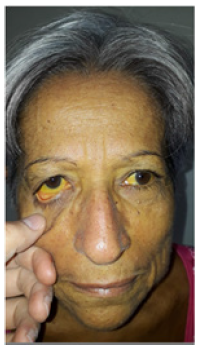Research Article 
 Creative Commons, CC-BY
Creative Commons, CC-BY
Tumor in the Pancreatic Head: A Case Report
*Corresponding author: Brian França dos Santos, Academic League of Gastroenterology and Digestive System Surgery, Iguaçu University, Brazil
Received: April 01, 2020;Published: April 09, 2020
DOI: 10.34297/AJBSR.2020.08.001282
Introduction
The Pancreatic adenocarcinoma affects the pancreatic head in 60 to 70% of cases, most cases with cholestasis, increased blood levels of direct bilirubin (a breakdown product of hemoglobin) with the clinic at the moment of the diagnosis [1]. Pancreatic cancer is usually diagnosed in subjects older than 40 years-old and its prevalence peaks at the age of 70 years-old. Surgical resection represents the only therapeutic alternative with a better chance of cure [2]. Pancreatic cancer has a high mortality rate due to late diagnosis and aggressive behavior. The prognosis is poor, with 5-year survival occurring in less than 5% of cases. The addition of modern diagnosis methods associated to the improvement of the other methods that already exist has given rise to controversy regarding to the best way of diagnosing and tumor staging. Likewise, the role of surgery in palliation and technical aspects of the located injuries resection are far from reaching consensus on practice [3,4].
Methods
The data was obtained from collecting information by anamnesis from the patient medical record at Hospital Geral de Nova Iguaçu, in addition to laboratory tests and other images relevant to this study. The images were collected along with the Hospital’s Radiology Department after the term of responsibility was signed. The case report was made after researching of terms of interest at PubMed and SciELO using as criterion of inclusion published articles between 2015 and 2020, with the following descriptors “Pancreas” and/or “Adenocarcinoma” and/or “Diagnosis” and/or “Surgery” and/or preoperative biliary tree drainage and full articles
Case Report
SDM, female, 68 years-old, living in the city of Nova Iguaçu, state of Rio de Janeiro. The patient mentions pain that started one month ago at palpation on her right upper abdomen, which radiated to the back and got worse during eating. She reports that simultaneously started jaundice (Figure A, B & C) 3 days later with acholia and choluria. Also reported weight loss of about 10 to 15 kilos. She has diabetes and is hypertensive.
She also reported hiatus hernia, gastro esophageal reflux disease and gastric ulcers. She performed two cesarean sections and cervical removal surgery due to uterine prolapse, also cholecystectomy. Patient is undergoing treatment for breast cancer, evolved to jaundice (Figure A, B & C) and abdominal pain. The means of fine needle aspiration biopsy was negative for malignancy, bone scintigraphy was inconclusive, computerised tomography (CT) of the abdomen shows dilatation of extra hepatic biliary ducts, pancreas head dilation.
Discussion
The tumor staging is fundamental and it must be done with the purpose of determining the candidates of the surgical procedure. It is based on the size of the tumor, on the vascular and lymph nodes affection and on the presence of distant metastasis, whereas these three requirements are responsible for including the patient in the three possible clinical categories: resectable, local advanced stage or metastatic tumor.
The literature claims that the use of preoperative biliary tree drainage is still a reason of disagreement. Considering present evidences and the prospective randomized studies already published, the authors conclude that the preoperative biliary tree drainage must not be done routinely on patients with resectable pancreatic head tumor when the definitive surgery is available in one week at a center of reference.
Conclusion
The ductal adenocarcinoma of the head of the pancreas (DAHP) presents itself to be the most aggressive tumor of his class with worse clinical prognosis. The Ductal adenocarcinoma of the head of the pancreas shows the extremely aggressive disease, with the worst prognostic factors being old age, presence of comorbidities, previous history of cancer and complications in the postoperative period [3].
References
- Santos BC, de Araujo FCF, Sanches MD (2018) Preoperative biliary drainage in pancreatic head adenocarcinoma: case report and literature review/Drenagem biliar pre operatoria no cancer de cabeca de pancreas: relato de caso e revisao da literatura. Revista de Medicina97(4): 422-433, 2018.
- Kamisawa T, Wood LD, Itoi T, Takaori K (2016) Pancreatic cancer. Lancet 388(10039): 73-85.
- Da Silveira Santos JPL, Machado CJ, Junior EP, Rodrigues JBSR, Vidigal PT, et al. (2018) Immuno histo chemical Predictors for Intestinal and Pancreatobiliary Types of Adenocarcinoma of The Ampulla of Vater. J Gastrointest Surg 22(7): 1171-1178.






 We use cookies to ensure you get the best experience on our website.
We use cookies to ensure you get the best experience on our website.